|
Guided Tour of Grand Canyon National Park |
|---|
When visiting the south rim of the Grand Canyon you may enter the park from the south at the south entrance station, which is a few miles north of the village of Tusayan, or from the east entrance station, near Desert View, out on the Desert View Drive.
When visiting the north rim of the Grand Canyon you will always enter the park at the north entrance station which is about 30 miles south of Jacob Lake.
After paying the admission fee at the entrance station you will receive a copy of the park newspaper, THE GUIDE. A separate copy of THE GUIDE is published for both the north and south rims. Both publications describe many things to see and do at Grand Canyon National Park. They give times for all of the ranger programs and other activities, list the times for sunrise and sunset and offer some suggestions on the best viewing areas for these events, contain maps of the village areas and the East and Hermit Roads on the south rim as well as the park roads on the north rim, and describe many of the facilities and services that are available in the area. In addition, they give some limited information and offers some suggestions for hiking and camping.
[ South Rim - South Entrance | South Rim - East Entrance | South Rim - Grand Canyon Village, Historic District | North Rim ]
South Rim - South Entrance Station |
|---|
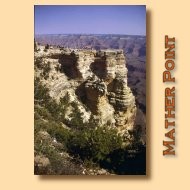
 Assuming you are entering the park via the south entrance station your first stop will probably be the canyon overlook at Mather Point. The view from this overlook is one of the finest and represents the first view that many visitors have of the Grand Canyon.
Assuming you are entering the park via the south entrance station your first stop will probably be the canyon overlook at Mather Point. The view from this overlook is one of the finest and represents the first view that many visitors have of the Grand Canyon.
Directly across the road from Mather Point is the Canyon View Center, the new main visitor center for the south rim. There also a combination book / gift / souvenier shop here which is operated by the Grand Canyon Association.
Your next stop beyond that should be the Yavapai Observation Station at Yavapai Point. This overlook also offers some spectacular views of this section of the canyon and you can even glimpse some small portions of the inner canyon, including Phantom Ranch. The Yavapai Observation Station has some small exhibits describing the geological history of the Grand Canyon, a bookstore which is operated by the Grand Canyon Association and a number picture windows which look out into the canyon. Plaques below each window describe the various scenes at which you are looking.
On the other side of the road from the main visitor center is the main shopping plaza for Grand Canyon Village. This is where the General Store is located as well as the post office. Yavapai Lodge is also located here along with its restaurant and gift shop.
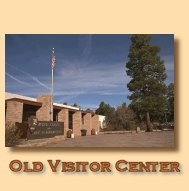
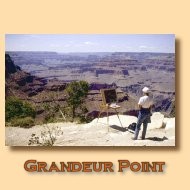 Beyond Yavapai Point you could stop at the old visitor center to and see if the Park Service has decided to do anything with it. There is also a historic cemetary located near the old visitor center where many famous Grand Canyon pioneers are buried. For the total Canyon experience leave your car at Yavapai Point and walk the 3/4 mile along the rim trail to the old Visitor Center. The easy walk along this paved trail offers some additional splendid views of the Canyon and of the Pinon-Juniper forest that occupies most of the south rim.
You will also pass Grandeur Point which offers an excellent view of he inner canyon and also of the Bright Angel Trail ascending from its depths. The main visitor center will give you additional information about visiting Grand Canyon including maps and brochures. It also offers exhibits describing the natural and cultural history of the Grand Canyon and offers a variety of audio-visual presentations.
Beyond Yavapai Point you could stop at the old visitor center to and see if the Park Service has decided to do anything with it. There is also a historic cemetary located near the old visitor center where many famous Grand Canyon pioneers are buried. For the total Canyon experience leave your car at Yavapai Point and walk the 3/4 mile along the rim trail to the old Visitor Center. The easy walk along this paved trail offers some additional splendid views of the Canyon and of the Pinon-Juniper forest that occupies most of the south rim.
You will also pass Grandeur Point which offers an excellent view of he inner canyon and also of the Bright Angel Trail ascending from its depths. The main visitor center will give you additional information about visiting Grand Canyon including maps and brochures. It also offers exhibits describing the natural and cultural history of the Grand Canyon and offers a variety of audio-visual presentations.
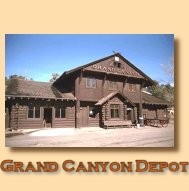
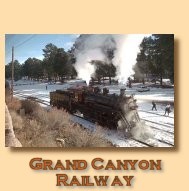 Beyond the Visitor Center and shopping area you enter the Historic District of Grand Canyon Village. This is where the old Grand Canyon Depot is located and if you are lucky enough you may even get to see the rebuilt engine number 18 of the Grand Canyon Railway at the station. The train normally arrives at Grand Canyon around noon or so and departs for Williams again at around 4:00 PM. It operates everyday during from late spring through early autumn and on weekends only during the rest of the year. It is quite a spectacle to watch the train arrive or depart. So many people have been using the train these days that they normally have to throw a diesel engine in behind old number 18, to help pull the coaches.The parking lot next station is one of the better places to park if you are just visiting for the day.
Some of the hotels in the area have some small parking lots but it is better to leave the space in these available for people that will actually be staying at them. During peak tourist season, which is most of the year, the parking situation at Grand Canyon is a nightmare. If you don't really need your car you would be advised to drive it to Williams and take the train up to the Canyon
Beyond the Visitor Center and shopping area you enter the Historic District of Grand Canyon Village. This is where the old Grand Canyon Depot is located and if you are lucky enough you may even get to see the rebuilt engine number 18 of the Grand Canyon Railway at the station. The train normally arrives at Grand Canyon around noon or so and departs for Williams again at around 4:00 PM. It operates everyday during from late spring through early autumn and on weekends only during the rest of the year. It is quite a spectacle to watch the train arrive or depart. So many people have been using the train these days that they normally have to throw a diesel engine in behind old number 18, to help pull the coaches.The parking lot next station is one of the better places to park if you are just visiting for the day.
Some of the hotels in the area have some small parking lots but it is better to leave the space in these available for people that will actually be staying at them. During peak tourist season, which is most of the year, the parking situation at Grand Canyon is a nightmare. If you don't really need your car you would be advised to drive it to Williams and take the train up to the Canyon

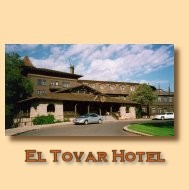 Also located in the Historic District, perched right on the rim of the Canyon are Hopi House and the El Tovar Hotel. To reach the either just climb up the hill next to the railway station. There is some limited parking available at the top next to the hotel, behind Hopi House, if you are physically challenged (or real lazy), otherwise leave it for the hotel guests. If you like to walk and you want to leave your car at the Yavapai Observation station, all of the rim sites are accessible via the rim trail. You can walk from the observation station to the visitor center and continue on along to the Historic District on the rim. The views of the Canyon from along the rim walk are fantastic. Both Hopi House and the El Tovar where designed by Mary Jane Coulter and both have a rich history.
Also located in the Historic District, perched right on the rim of the Canyon are Hopi House and the El Tovar Hotel. To reach the either just climb up the hill next to the railway station. There is some limited parking available at the top next to the hotel, behind Hopi House, if you are physically challenged (or real lazy), otherwise leave it for the hotel guests. If you like to walk and you want to leave your car at the Yavapai Observation station, all of the rim sites are accessible via the rim trail. You can walk from the observation station to the visitor center and continue on along to the Historic District on the rim. The views of the Canyon from along the rim walk are fantastic. Both Hopi House and the El Tovar where designed by Mary Jane Coulter and both have a rich history.
Next to the El Tovar Hotel, to the east, you will find Hopi House, a gift shop specializing in native American handicrafts. A little further east from that is Vercamps, another gift shop that has a wide variety if souvenir items.
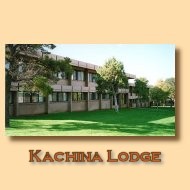
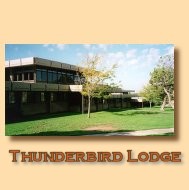 Heading west from the El Tovar along the rim trail you will pass the Kachina and Thunderbird Lodges as well as the Arizona Steakhouse before arriving at the Bright Angel Lodge overlook. The Arizona Steakhouse is probably the finest place to eat on the rim. I would guess that the main dining room in the El Tovar is probably pretty nice as well, but they tend to serve more exotic dishes and tend to be higher priced. The prices are the Arizona Steakhouse are higher than those at some of the other establishments but the quality of the food and the service is excellent and worth the higher price. I usually reserve a night out at the Arizona Steakhouse for a special occasion,
such as the completion of a hie. Another good place to eat the the restaurant at the Bright Angel Lodge itself. This food here is very good and is reasonably priced and the wait staff loves to talk to the tourists and some of them can spin quite the yarn. This is where I normally eat when staying in the village area. The breakfasts are fabulous and make for a great meal before starting a hike into the Canyon.
Heading west from the El Tovar along the rim trail you will pass the Kachina and Thunderbird Lodges as well as the Arizona Steakhouse before arriving at the Bright Angel Lodge overlook. The Arizona Steakhouse is probably the finest place to eat on the rim. I would guess that the main dining room in the El Tovar is probably pretty nice as well, but they tend to serve more exotic dishes and tend to be higher priced. The prices are the Arizona Steakhouse are higher than those at some of the other establishments but the quality of the food and the service is excellent and worth the higher price. I usually reserve a night out at the Arizona Steakhouse for a special occasion,
such as the completion of a hie. Another good place to eat the the restaurant at the Bright Angel Lodge itself. This food here is very good and is reasonably priced and the wait staff loves to talk to the tourists and some of them can spin quite the yarn. This is where I normally eat when staying in the village area. The breakfasts are fabulous and make for a great meal before starting a hike into the Canyon.
If you continue west from the Kolb Studio you will shortly arrive at the trailhead for the
Bright Angel Trail. Beyond this point the rim trail continues all the way to Hermit's Rest which is still some 8 miles away. I have done it before and it is an excellent walk but may be a little too much for some people. From late spring to early autumn the park service operates a shuttle bus along the Hermit Road that stops at all of the overlooks. This service is provided free of charge. During this season the Hermit Road is closed to automobile traffic. You can also rent bicycles in the village and tour the West Rim and be "green" at the same time. During the off season your only choices are doing it on foot or in your car.
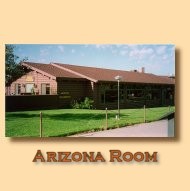
 The whole stretch of rim trail between the El Tovar and the head of the Bright Angel Trail will be a seething mass of people during prime tourist season and unless you are into this kind of thing you may want to avoid it during the busiest part of the day. During the off season and in the early morning hours right before sunrise it is delightful. The biggest part of the masses tend to congregate right outside the Bright Angel Lodge gift shop next to the Bright Angel Fountain. The combination of the gift shop, and the fountain, which sells ice cream and snacks, and the incredible view makes this a very popular spot. It's sad to think that this is the only view of the Canyon that some people ever get to see.
The whole stretch of rim trail between the El Tovar and the head of the Bright Angel Trail will be a seething mass of people during prime tourist season and unless you are into this kind of thing you may want to avoid it during the busiest part of the day. During the off season and in the early morning hours right before sunrise it is delightful. The biggest part of the masses tend to congregate right outside the Bright Angel Lodge gift shop next to the Bright Angel Fountain. The combination of the gift shop, and the fountain, which sells ice cream and snacks, and the incredible view makes this a very popular spot. It's sad to think that this is the only view of the Canyon that some people ever get to see.

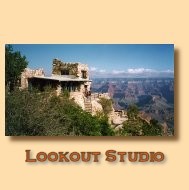 Continuing west along the rim trail from the Bright Angel Lodge you will pass the Bucky O'Neil cabin, and the Lookout Studio before coming to the Kolb Studio. A visit to the Kolb Studio is a must. The studio was originally built and operated by the Kolb brothers, Emery and Ellsworth, and has a very interesting history. The Grand Canyon Association is in the process of renovating the building and currently operates a book store in the front room and all of the proceeds from sales made here go directly to restoration costs for the studio. In the auditorium you will normally find some sort of exhibit relating to the cultural and/or geologic history of the Grand Canyon. An exhibit that ran recently was entitled "Traditional Native American Basketry and Contemporary Weaving".
Continuing west along the rim trail from the Bright Angel Lodge you will pass the Bucky O'Neil cabin, and the Lookout Studio before coming to the Kolb Studio. A visit to the Kolb Studio is a must. The studio was originally built and operated by the Kolb brothers, Emery and Ellsworth, and has a very interesting history. The Grand Canyon Association is in the process of renovating the building and currently operates a book store in the front room and all of the proceeds from sales made here go directly to restoration costs for the studio. In the auditorium you will normally find some sort of exhibit relating to the cultural and/or geologic history of the Grand Canyon. An exhibit that ran recently was entitled "Traditional Native American Basketry and Contemporary Weaving".
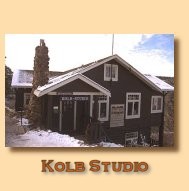
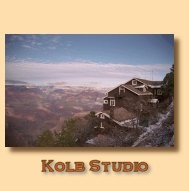

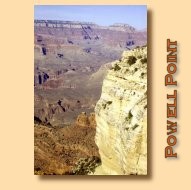 There are many fine overlooks along the Hermit Road, the one pictured here being the Powell Point overlook. The overlooks that you will pass from from the village on your way to Hermit's Rest are as follows:
There are many fine overlooks along the Hermit Road, the one pictured here being the Powell Point overlook. The overlooks that you will pass from from the village on your way to Hermit's Rest are as follows:
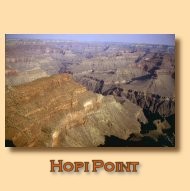
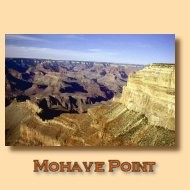
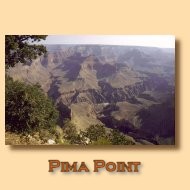
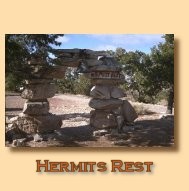
 At the end of the Hermit Road you will come to Hermit's Rest. This is the end of the road unless you want to take to the trail. The trailhead for the Hermit Trail starts about 1/4 mile down the dirt road that continues to the west.
At the end of the Hermit Road you will come to Hermit's Rest. This is the end of the road unless you want to take to the trail. The trailhead for the Hermit Trail starts about 1/4 mile down the dirt road that continues to the west.
South Rim - East Entrance Station |
|---|

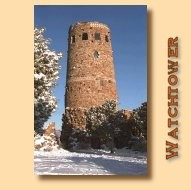 Assuming you enter the park from the East Entrance Station your first stop will be Desert View. There is a smaller version of the Grand Canyon Village shopping area here where you will find a General Store, a small visitors center, and a combination gift shop and restaurant. This is also where Watchtower at Desert View is located. If you continue west along the Desert View Drive you will encounter the following overlooks and turnouts:
Assuming you enter the park from the East Entrance Station your first stop will be Desert View. There is a smaller version of the Grand Canyon Village shopping area here where you will find a General Store, a small visitors center, and a combination gift shop and restaurant. This is also where Watchtower at Desert View is located. If you continue west along the Desert View Drive you will encounter the following overlooks and turnouts:
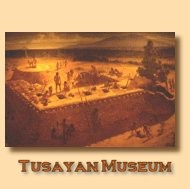
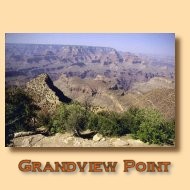 |
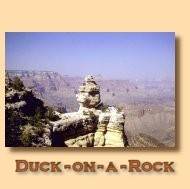
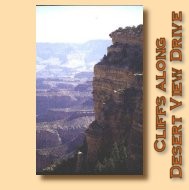 Between the main, named overlooks there are some smaller unnamed turnouts that also offer some wonderful views of the canyon. One of my favorites is the Duck-on-a-Rock turnout which is located between Grandview and Yaki Points.
Between the main, named overlooks there are some smaller unnamed turnouts that also offer some wonderful views of the canyon. One of my favorites is the Duck-on-a-Rock turnout which is located between Grandview and Yaki Points.
North Rim |
|---|
Your tour of the north rim begins even before you enter the park. The drive from Jacob Lake to the north rim entrance station is quite scenic. The road winds its way through a landscape that is primarily a sub-alpine forest which is dotted here and there with large meadows which are in turn dotted small lakes. It's quite a change over the arid terrain that you had to pass through in getting to the north rim.
The north rim entrance station is about 30 miles south of Jacob Lake and the rim itself is another 9 miles from there. The lodge area is first stop for most people when visiting the north rim. The Grand Canyon Lodge is a landmark in itself and if you would like to talk to a ranger and get your bearings before starting to explore the area, this is the best place to start.
Some other nice walks in the area can be found along the Transept Trail which runs along The Transept from Grand Canyon Lodge to the camping area.
The veranda of the Grand Canyon Lodge is a nice place to simply sit back and relax and an awesome spot from which to watch sunrise or sunset.
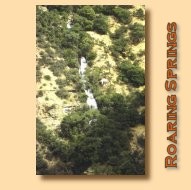
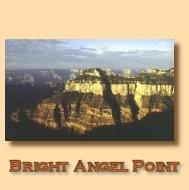 From the lodge you can also walk the paved half-mile mile trail out to Bright Angel Point for a spectacular view of the Canyon. From here you should be able to hear the roar of Roaring Springs some 3,000 feet below you to the east. Roaring springs is the only water source for both rims.
From the lodge you can also walk the paved half-mile mile trail out to Bright Angel Point for a spectacular view of the Canyon. From here you should be able to hear the roar of Roaring Springs some 3,000 feet below you to the east. Roaring springs is the only water source for both rims.
 Once you're finished in the lodge area you will probably want to see some more of the park. To do this you first have to backtrack along the park road to the road that leads to Point Imperial and Cape Royal. The junction for this road will be about 3 miles back from the lodge area, on your right, just after the marker for the North Kaibab Trailhead. After about 5 miles the road you are on will split, the let fork going to Point Imperial and the right fo
rk to Cape Royal.
Once you're finished in the lodge area you will probably want to see some more of the park. To do this you first have to backtrack along the park road to the road that leads to Point Imperial and Cape Royal. The junction for this road will be about 3 miles back from the lodge area, on your right, just after the marker for the North Kaibab Trailhead. After about 5 miles the road you are on will split, the let fork going to Point Imperial and the right fo
rk to Cape Royal.
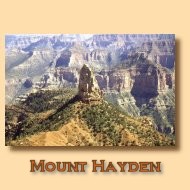 After another 3 miles or so you will arrive at Point Imperial. Point Imperial is the highest point on either rim, having an elevation of 8803 feet. From here you will see some very majestic views of the Painted Desert, to the east; of Mount Hayden, to the southeast; and of Saddle Mountain, to the northeast. Saddle Mountain marks the start of the Nankoweap Trail, which leads adventurous backpackers 14 miles out and 6,000 feet down to the Nankoweap Ruins at the Colorado River.
After another 3 miles or so you will arrive at Point Imperial. Point Imperial is the highest point on either rim, having an elevation of 8803 feet. From here you will see some very majestic views of the Painted Desert, to the east; of Mount Hayden, to the southeast; and of Saddle Mountain, to the northeast. Saddle Mountain marks the start of the Nankoweap Trail, which leads adventurous backpackers 14 miles out and 6,000 feet down to the Nankoweap Ruins at the Colorado River.
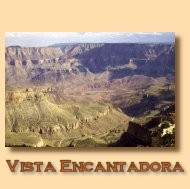 To continue your tour from Point Imperial you must head back to the road junction and bear left to take the road to Cape Royal. Along the way you may wish to stop at the Vista Encantadora overlook, for another impressive view of the Painted Desert to the east. Just before you reach Cape Royal you may also want to stop at the Walhalla Overlook for a good view of the Unkar Creek area below and to visit the Anasazi ruins located nearby.
To continue your tour from Point Imperial you must head back to the road junction and bear left to take the road to Cape Royal. Along the way you may wish to stop at the Vista Encantadora overlook, for another impressive view of the Painted Desert to the east. Just before you reach Cape Royal you may also want to stop at the Walhalla Overlook for a good view of the Unkar Creek area below and to visit the Anasazi ruins located nearby.
 After about 17 miles journey from Point Imperial you will arrive at Cape Royal. Once at Cape Royal you may wish to hike the short half-mile trail to view the Angel's Window and then proceed to the tip of Cape Royal. The Angel's Window is a very large natural arch that has been eroded out of a fin of rock that protrudes out into the Canyon. The trail also goes over the arch to viewpoint on the tip of the fin. Cape Royal itself provides some excellent views of the inner canyon and many of the temples and buttes within.
After about 17 miles journey from Point Imperial you will arrive at Cape Royal. Once at Cape Royal you may wish to hike the short half-mile trail to view the Angel's Window and then proceed to the tip of Cape Royal. The Angel's Window is a very large natural arch that has been eroded out of a fin of rock that protrudes out into the Canyon. The trail also goes over the arch to viewpoint on the tip of the fin. Cape Royal itself provides some excellent views of the inner canyon and many of the temples and buttes within.
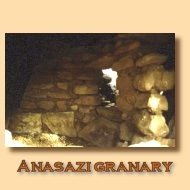 Another trail, the Cliff Springs Trail, leads off the west just opposite the Angel's Window Overlook. This trail will lead you to Cliff Spring and back, a 2 mile round-trip. Along the way there are ruins of granary that was built and used by the Anasazi indians that once inhabited the area.
Another trail, the Cliff Springs Trail, leads off the west just opposite the Angel's Window Overlook. This trail will lead you to Cliff Spring and back, a 2 mile round-trip. Along the way there are ruins of granary that was built and used by the Anasazi indians that once inhabited the area.
|
|
|---|
|
|---|